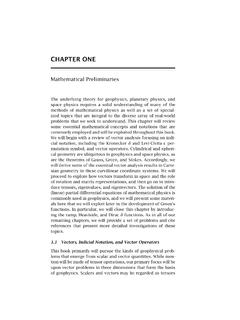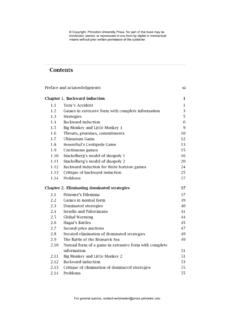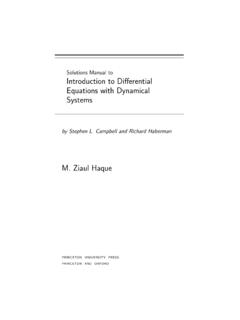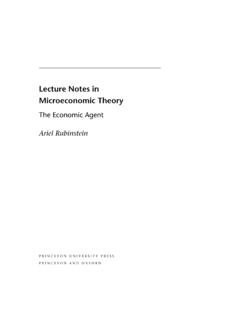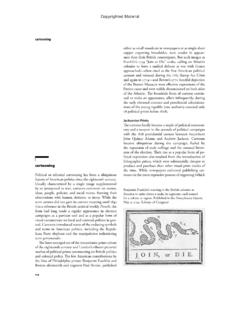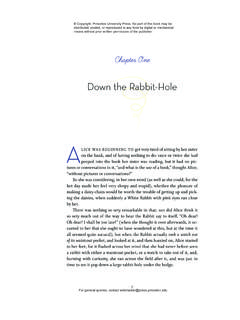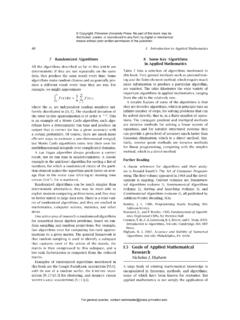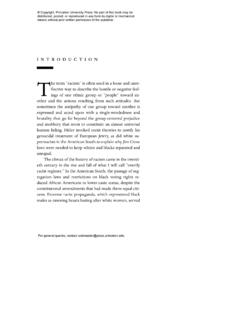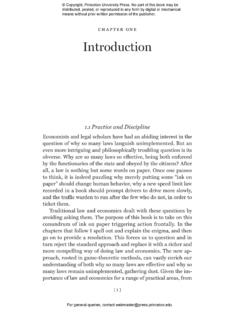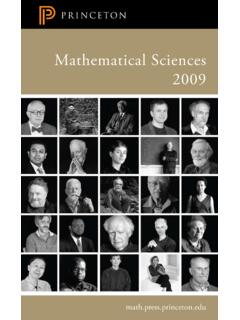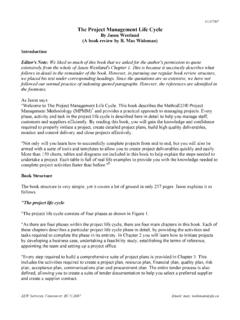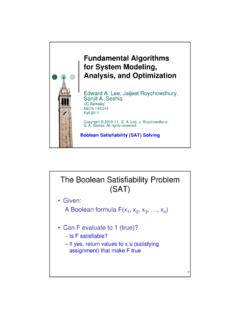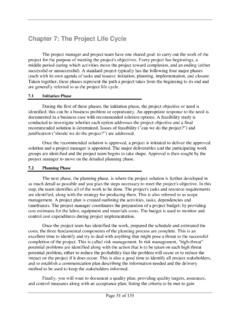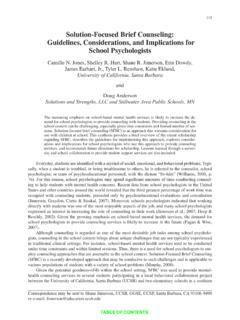Transcription of Solution Manual Game Theory: An Introduction
1 Solution ManualGame theory : An IntroductionSteve TadelisJanuary 31, 2013 Copyright, Princeton University Press. No part of this book may be distributed, posted, or reproduced in any form by digital or mechanical means without prior written permission of the publisher. ABSTRACT This Solution Manual includes only the even numbered questions andis available for public access. It is still incomplete. It will be updated every 2-3 weeksto add the solutions to problems as they become available. A complete version isexpected by March 15, 2013.
2 Copyright, Princeton University Press. No part of this book may be distributed, posted, or reproduced in any form by digital or mechanical means without prior written permission of the publisher. ContentsI Rational Decision Making21 The Single-Person Decision Problem32 Introducing Uncertainty and Time9II Static games of Complete Information213 Preliminaries234 Rationality and Common Knowledge275 Pinning Down Beliefs: Nash Equilibrium356 Mixed Strategies51 Copyright, Princeton University Press.
3 No part of this book may be distributed, posted, or reproduced in any form by digital or mechanical means without prior written permission of the publisher. Contents 1 III Dynamic games of Complete Information627 Preliminaries638 Credibility and Sequential Rationality73 Copyright, Princeton University Press. No part of this book may be distributed, posted, or reproduced in any form by digital or mechanical means without prior written permission of the publisher. Part IRational Decision Making2 Copyright, Princeton University Press.
4 No part of this book may be distributed, posted, or reproduced in any form by digital or mechanical means without prior written permission of the publisher. 1 The Single-Person Decision to the Movies:There are two movie theatres in your neighbor-hood: Cineclass, which is located one mile from your home, and Cineblast,located 3 miles from your home, each showing ,Gone with the WindandDr. Strangelove, while Cineblastis showingThe Matrix,Blade RunnerandAliens. Your problem is to decidewhich movie to go to.
5 (a) Draw a decision tree that represents this problem without : Copyright, Princeton University Press. No part of this book may be distributed, posted, or reproduced in any form by digital or mechanical means without prior written permission of the publisher. 41. The Single-Person Decision Problem (b) Imagine that you don t care about distance and that your preferencesfor movies is alphabetic ( , you likeAliensthe most andThe Matrixthe least.) Using payoffvalues 1 through 6 complete the decision treeyou drew in part (a).
6 What option would you choose?Answer: (c) Now imagine that your car is in the shop, and the cost of walking eachmile is equal to one unit of in the decisiontree. Would your choice change?Answer: Consumption:Recall the example in which you needed to choosehow much to drink. Imagine that your payofffunction is given by 4 2 Copyright, Princeton University Press. No part of this book may be distributed, posted, or reproduced in any form by digital or mechanical means without prior written permission of the publisher.
7 1. The Single-Person Decision Problem 5where is a parameter that depends on your physique. Every person mayhave a different value of , and it is known that in the population ( )thesmallest is0 2;( ) the largest is6;and( )largerpeoplehavehigher sthan smaller people.(a) Can youfind an amount of drinking that no person should drink?Answer:The utility from drinking 0 is equal to 0. If a decision makerdrinks =2then, if he has the largest =6,hispayoffis =6 2 4 (2)2= 4and it is easy to see that decision makers with smallervalues of will obtain an even more negative payofffrom consuming =2.
8 Hence, no person should choose =2. (b) How much should you drink if your =1?If =4?Answer:The optimal Solution is obtained by maximizing the payofffunction ( )= 4 maximization condition is 8 =0implying that = 8is the optimal Solution . For =1thesolution is =18and for =4it is =12. (c) Show that in general, smaller people should drink less than larger :This follows from the Solution in part (b) above. For everytype of person , the Solution is ( )= 8which is increasing in ,andlarger people have higher values of (d) Should any person drink more than one bottle of wine?
9 Answer:No. Even the largest type of person with =6should onlyconsume =34of a bottle of wine. Trees:You have room for up to two fruit bearing trees in your fruit trees that can grow in your garden are either apple, orange or cost of maintenance is $100 for an apple tree, $70 for an orange tree and$120 for a pear tree. Your food bill will be reduced by $130 for each apple Copyright, Princeton University Press. No part of this book may be distributed, posted, or reproduced in any form by digital or mechanical means without prior written permission of the publisher.
10 61. The Single-Person Decision Problemtree you plant, by $145 for each pear tree you plant and by $90 for eachorange tree you plant. You care only about your total expenditure in makingany planting decisions.(a) What is the set of possible actions and related outcomes?Answer:Youhavetwo slots thatcanbeleftempty,orhaveoneof3possible trees planted in each slot. Hence, you have 10 possible (b) What is the payoffof each action/outcome?Answer:To calculate the payoffsfromeachchoiceitisconvenienttouse atableasfollows:Choicecost food savings net payoffnothing00 0one apple tree10013030one orange tree709020one pear tree12014525two apple trees20026060two orange trees14018040two pear trees24029050apple and orange17022050apple and pear22027555pear and orange19023545(c) Which actions are dominated?
